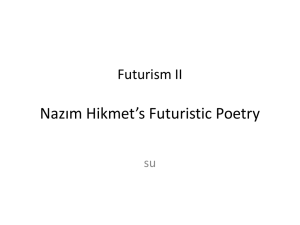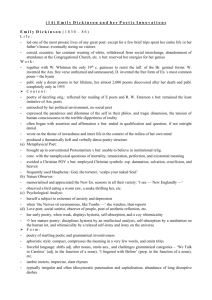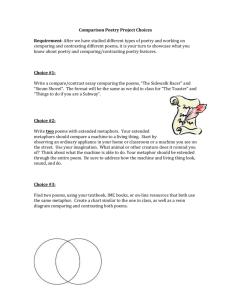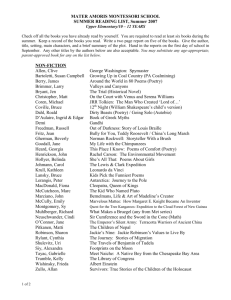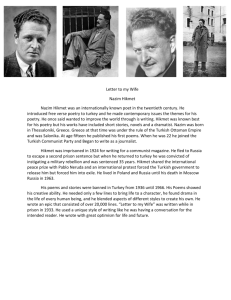nazim hikmet and concept of humanity in his works
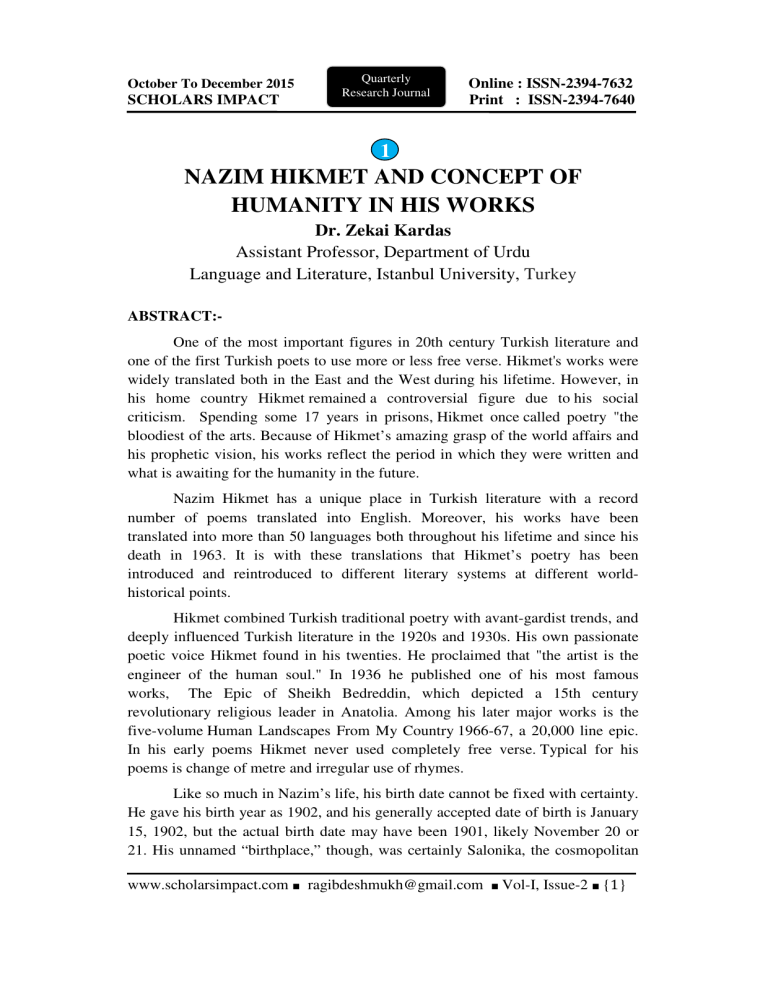
October To December 2015
Research Journal
Online : ISSN-2394-7632
SCHOLARS IMPACT Print : ISSN-2394-7640
1
NAZIM HIKMET AND CONCEPT OF
HUMANITY IN HIS WORKS
Dr. Zekai Kardas
Assistant Professor, Department of Urdu
Language and Literature, Istanbul University, Turkey
ABSTRACT:-
One of the most important figures in 20th century Turkish literature and one of the first Turkish poets to use more or less free verse. Hikmet's works were widely translated both in the East and the West during his lifetime. However, in his home country Hikmet remained a controversial figure due to his social criticism. Spending some 17 years in prisons, Hikmet once called poetry "the bloodiest of the arts. Because of Hikmet’s amazing grasp of the world affairs and his prophetic vision, his works reflect the period in which they were written and what is awaiting for the humanity in the future.
Nazim Hikmet has a unique place in Turkish literature with a record number of poems translated into English. Moreover, his works have been translated into more than 50 languages both throughout his lifetime and since his death in 1963. It is with these translations that Hikmet’s poetry has been introduced and reintroduced to different literary systems at different worldhistorical points.
Hikmet combined Turkish traditional poetry with avant-gardist trends, and deeply influenced Turkish literature in the 1920s and 1930s. His own passionate poetic voice Hikmet found in his twenties. He proclaimed that "the artist is the engineer of the human soul." In 1936 he published one of his most famous works, The Epic of Sheikh Bedreddin, which depicted a 15th century revolutionary religious leader in Anatolia. Among his later major works is the five-volume Human Landscapes From My Country 1966-67, a 20,000 line epic.
In his early poems Hikmet never used completely free verse. Typical for his poems is change of metre and irregular use of rhymes.
Like so much in Nazim’s life, his birth date cannot be fixed with certainty.
He gave his birth year as 1902, and his generally accepted date of birth is January
15, 1902, but the actual birth date may have been 1901, likely November 20 or
21. His unnamed “birthplace,” though, was certainly Salonika, the cosmopolitan www.scholarsimpact.com
■
ragibdeshmukh@gmail.com
■
Vol-I, Issue-2
■
{ 1 }
October To December 2015
Research Journal
Online : ISSN-2394-7632
SCHOLARS IMPACT Print : ISSN-2394-7640 port city of Macedonia. The center of the Ottomans in Europe, the city hosted the various peoples of the Ottoman Empire. Although Muslims, Christians, Jews,
Turks, Greeks, Slavs, and Albanians mixed and merged there, it was primarily a
Jewish city. Also the birthplace, in 1881 of Mustafa Kemal Atatürk, the founder of the Republic of Turkey, Salonika was a projection in miniature, The place, functioning organism by which the Turks had held together for five centuries a disparity of races of East and West and not just of races but religions, cultures, and languages it was also the center of political reformist movements, a venue for importing Western liberal democratic thought into the empire. The Union and
Progress movement of the Young Turks was a Macedonian movement, and when
Nâzim was born, his father, Hikmet Nâzim Bey, was a Unionist stationed in the
Foreign Service in Salonika.
i
Nâzim came from the Ottoman upper class. He was the grandson of pashas on both sides of the family. Hikmet Bey’s father was poet. Mehmet Nâzim Pasha, the governor of Diyarbakir, Aleppo, and Konya and the last governor of Salonika in 1912, before the city was ceded to Greece in 1913. His mother, Celile Hanim, was the daughter of linguist Enver Pasha, an early proponent of language reform.
One of her grandfathers was marshal Mehmet Ali Pasha, a Huguenot of French-
Protestant descent born in Brandenburg. He jumped a naval training ship in
Istanbul and was picked up by Turkish sailors, raised by the Vizier Ali Pasha, and advanced to the ranks of pashas. Dispatched to put down an uprising in Rumelia, he was killed, at forty-four, by Albanians.
ii
Nâzim also came from a poetic background: “In our house, despite my father’s indifference to literature, poetry took center stage” iii . Both his parents spoke French, and his mother read him French poets. But his paternal grandfather,
Mehmet Nâzim Pasha, was the most important figure in his early life. After leaving Salonika, Nâzim’s family, now including his sister Samiye, moved to live with Mehmet Nâzim Pasha in Diyarbakir and then in Aleppo, which at the time were outposts where liberal thinkers could be safely stationed. Nâzim Pasha was a poet and a Sufi, a follower of Mevlana Celaleddin Rumi; he had published books on poetry and literature and had a good library. Nâzim said, “My grand-father was a poet, but I still don’t understand his poems. He wrote in a language we call
Ottoman, made up of seventy-five percent Arabic and Persian words, and a
Turkish following Arabic and Persian grammar. His were didactic, religious poems. I did not understand them. But I was the grandson of a poet. My mother loved Lamartine. She’d read him in French. . . . She knew French very well, but she didn’t know Ottoman. Like me.” Nâzim also grew up with the Anatolian stories and songs of his grandfather’s servants. At a very early age he heard from www.scholarsimpact.com
■
ragibdeshmukh@gmail.com
■
Vol-I, Issue-2
■
{ 2 }
October To December 2015
Research Journal
Online : ISSN-2394-7632
SCHOLARS IMPACT Print : ISSN-2394-7640 them some of the folk tales and epics he would later rework in his poems and plays.
iv
Nâzim’s mystical strain and his ear for Ottoman measures may be traced back to his grandfather. In Life’s Good, Ahmet remembers how his grandfather used to put him to sleep reciting Rumi’s Mesnevi instead of lullabies. Mesnevi,
Rumi’s masterwork, is in quantitative meters and has the status of a sacred book among his followers. Yet this background also accounts for Ahmet’s atheism:
“One of the reasons I slipped so easily out of God’s grasp is that in Anatolia I saw the man of religion at work. This man was not like my Sufi grandfather, or our boarding school’s religion teacher in his suit and tie, or even the jovial imam of our neighborhood mosque in Üsküdar. This man, like the ogres in fairy tales, had settled at the fountainhead and cut off the water supply. Over him ruled superstition, hypocrisy, and intolerance—a dark banner of terror”.
v
The conversations in the gatherings of Nâzim’s grandfather’s Sufi friends, where poetry was regularly recited, left their mark on his work. Rumi was exalted by these men, who lived by his words, and Nâzim was not to take lightly this figure of the poet. Some lines, written when he was practically still a child, read:
“whirling, always whirling. / We begin in the same place, we end in the same place. / We say we move forward as we cross and recross one path” vi . A story
Nâzim told many times, and one many biographers repeat, goes that when Nâzim published his very early poem “Mevlana” and signed it “Mehmet Nâzim,”
Mehmet Nâzim Pasha’s friends mistook it for a poem by the pasha. Certainly the substance was recognizable, but Nâzim Pasha had to convince his friends that he could not possibly be the author of the poem, as it was in syllabic meters, while he wrote only in Ottoman, quantitative meters. Syllabics, the verse form based on the measures of Turkish folk poetry, was reclaimed by the new poets at the time, and
Nâzim was “translating” a Sufi view into the twentieth century and modern
Turkish rhythms.
vii
Many years later, Nâzim would respond to Rumi by making Rumi’s rubai form his own medium for defending his materialist philosophy.The poem that opens the First Series of Rubaiyat reads:
“The world you saw was real, Rumi, not an apparition. It is boundless and eternal, its painter is not the First Cause. And the best of the rubaiyat your burning flesh left us is not the one that goes, All forms are shadows” . viii
After lower school in Istanbul, Nâzim enrolled in Galatasaray Lisesi and started learning French, but when the school’s expense proved beyond Hikmet
Bey’s means, Nâzim transferred to Ni ş anta ş i Lisesi, a public school, in 1914 www.scholarsimpact.com
■
ragibdeshmukh@gmail.com
■
Vol-I, Issue-2
■
{ 3 }
October To December 2015
Research Journal
Online : ISSN-2394-7632
SCHOLARS IMPACT Print : ISSN-2394-7640
(Sülker,
Ş air 13). By this time, he had turned to writing love poems and then fervent patriotic poems, a number of them in memory of his uncle, Mehmet Ali, who died at Gallipoli in the Great War. The Minister of the Navy, Cemal Pasha, was a close family friend and arranged for Nâzim to enroll in the Naval Academy after hearing him read his patriotic poems.
ix
After The First World War, Nâzim’s decided to leave Istanbul for Turkish
Freedom Movement in Anatolia and join Kemal’s Nationalist forces. In Istanbul
Nâzim had already published poems that distinguished him as a poet who addressed the dire reality of his nation. At a time when other poets, partly afraid to speak out and partly too bewildered and overwhelmed by the current course of events, had taken cover under an “art for art’s sake” position—“as if they weren’t in this country, didn’t see or hear about this catastrophe”—Nâzim answered the need for a nationalist voice and politically committed verse x . There were many underground routes to Anatolia, and Nâzim escaped on January 1, 1921, on a boat—named aptly enough, The New World—smuggling weapons to Kemal’s forces. Vâlâ Nureddin (Vâ-Nû), and two older poets, Faruk Nafiz and Yusuf Ziya, accompanied Nâzim on this trip to Inebolu on the Black Sea. A Nationalist entry point, this small town was now packed with people waiting for clearance from
Kemal’s Ankara government.
xi
All this was part of his nineteenth-year experience. Nâzim’s notions of
Anatolia had been formed by the novels and poems that presented idealized pictures of simple, pastoral lives of the people, orientalist representations within the Eastern empire itself, and the reality of Anatolia was deeply disturbing. Later, in the twenties, when he focused on Western imperialism, Nâzim would forcefully address orientalism in “Pierre Loti.” Loti, a French naval officer and the author of Aziyade, a novel based on the time he spent in Istanbul, was a representative figure of European imperialism in Turkey in particular. This is
Nâzim on Loti’s “Orient”:
This is the Orient seen by the French poet!
This the Orient of books printed
1,000,000 copies a minute!
But not yesterday not today not tomorrow this Orient never was, never will be! www.scholarsimpact.com
■
ragibdeshmukh@gmail.com
■
Vol-I, Issue-2
■
{ 4 }
October To December 2015
Research Journal
Online : ISSN-2394-7632
SCHOLARS IMPACT Print : ISSN-2394-7640
The Orient is the barren earth where naked slaves starve to death!
The common property of everyone but the Oriental!
The land where hunger famishes death!
A wheat granary filled to the brim!
Europe’s granary! xii
The poverty and filth, the diseased and starving peasants, the wounded and dying soldiers he saw on route to Ankara, made for traumatic experiences for
Nâzim. Years of war had left only women and children in a barren country ravaged by hunger and typhus.
Nâzim’s experiences on his inland journey eventually led him to forge a new poetic idiom to sound the silence of Anatolia. He witnessed lives for which he knew no literary language. Neither the set forms and quantitative measures of
Ottoman verse, nor the syllabics of the new poets he was aligned with, could even register, let alone address these social and historical realities. The two traditional poetic forms in effect restricted the historical visibility and audibility of experiences that did not fall within the parameters of their lyric topoi—Humanity, love, loss, time, death, and so on.
xiii
While his eyes were being opened by time spent with the wounded and dying, he was also learning of Marx and Engels, of class struggle, the proletariat, and imperialism. Thus both his nationalist and internationalist commitments grew.
Intending to see the Russian Revolution at first hand, in late September 1921
Nazim decided to study socialism in Moscow. There Nazim developed a life-time long interest in cinema. He actively involved with film production in various ways not only in his early poems and in Human Landscapes but in his important late poems. The New Wave films of Alain Resnais, for example, likely had an impact on the major late poem “Straw-Blond,” with its disorienting sequences of jump cuts.59
In 1924 he returned to Istanbul, where he wrote for Socialist newspapers.
His reckless impulsivity did not make him a good TKP (Turkish Communist
Party) member; he broke away, forming his own alternative party. Still he is “an official and abiding bondage of the poet to the ideologue.” xiv www.scholarsimpact.com
■
ragibdeshmukh@gmail.com
■
Vol-I, Issue-2
■
{ 5 }
October To December 2015
Research Journal
Online : ISSN-2394-7632
SCHOLARS IMPACT Print : ISSN-2394-7640
His first book came in 1929, formal political poetry in a voice at once lyric and public. Although he was imprisoned for nine months, and blacklisted upon his release, he was the best selling and most widely read author in Istanbul. He remained an agitator, a loose cannon, charismatic, fearless, and outspoken; his poems led to his arrest in 1938 on the charge of inciting military cadets to revolt.
The subsequent twelve years in prison, made him into the poet he became.
He learned about hunger, poverty, and injustice as he listened to his fellow inmates, and he got to know the stories and legends, the idioms and the vernaculars, of Anatolian culture. Prison gave his poetry a social and historical breadth and texture—a broader range and a deeper resonance.
Gaining in conviction and authority, he managed, for the most part, to maintain his equilibrium and his optimism. He called Bursa Prison a “Stone
Airplane” in which he occasionally took wing:
I look at the night through the bars, and despite the weight on my chest my heart still beats with the most distant stars.
His prison poems are often communications with his wife. During his internment, Hikmet steadily wrote and translated, took up woodcarving, and set up a weaving cooperative, “his major enterprise.”
Formal appeal for his release began in 1949. Tristan Tzara founded the
“Save Nâzım Hikmet” committee in Paris, which included Éluard, Neruda, Sartre, and Picasso. Paul Robeson and Howard Fast were speaking out for Hikmet in the
U.S. The World Peace Council conference awarded him the International Peace
Prize and, in 1950, he was released, in very poor health. His first words were:
“Life’s beautiful, brother!” But the Turkish authorities were not done with him.
Soon a draft notice came. He fled to Moscow, where he lived on income from his poems and plays, becoming a “prominent figure in the Moscow theater.”
Constantly under surveillance in Russia, as he had been in Turkey, he traveled in
Europe “with his work for world peace,” and also to China, Africa, and Cuba
(always with a “shadow”). Hikmet died in exile in 1963.
xv
After his death, Hikmet's books began to reappear in Turkey; in 1965 and
1966, for example, more than twenty of his books were published there, some of them reprints of earlier volumes and others works appearing for the first time. The next fifteen years saw the gradual publication of his eight volume Collected
Poems, along with his plays, novels, letters, and even children's stories. At the same time, various selections of his poems went through multiple printings, and numerous biographies and critical studies of his poetry were published. But except for brief periods between 1965 and 1980, his work has been suppressed in his native country for the past half century. Since his death, major translations of www.scholarsimpact.com
■
ragibdeshmukh@gmail.com
■
Vol-I, Issue-2
■
{ 6 }
October To December 2015
Research Journal
Online : ISSN-2394-7632
SCHOLARS IMPACT Print : ISSN-2394-7640 his poetry has continued to appear in England, France, Germany, Greece, Poland,
Spain, and the United States; for example, Yannis Ritsos's Greek versions had gone through eight printings a of 1977, and Philippe Soupault's 1964 anthology was reissued in France as recently as 1982. And in 1983 alone, new translations of
Hikmet's poems were published in French, German, and Russian. A collection of
Hikmet's finest shorter poems in English translation, this book brings together for the first time -in substantially revised new versions- the better part of two earlier selections, the long-out-of-print Things I didn't know I loved and The Epic of
Sheik Bedrettin, as well as a number of important lyrics previously published in magazines but hitherto uncollected. Peoples of the world who are acquainted with
Nazim Hikmet's poems see in them the defence of their class interest, and a successful definition of their sorrow, their happiness and their aspirations. Against oppression, exploitation and inequalities, they see the praise of the ideals of freedom, justice and brotherhood. They hear the deep voice of peace, independence and democracy against fascism, imperialism and war. For all these reasons, they understand his poetry and they love it.
xvi
Nazim Hikmet is one of the classic poets of Turkey, a contemporary classic. His work is not only of a national value but also an international one. In terms of content and form he contributed to the world poetry as well as Turkish poetry.
Because Nazim Hikmet was committed to the science of the working class and its party, and he was active in organisational actions as well as publishing for the emancipation of poor people, he was punished heavily by the ruling circles:
He spent 15 years in prison. He had to escape abroad to save his life. He lived away from his beloved wife, son and his motherland. At the age of 61 he died in
Moscow in 1963, in pain and longing.
xvii
One of the contradictions of modern Turkey, where governmental suppression of journalists and writers is still a serious problem, is that Hikmet, the
“romantic Communist,” is almost universally acknowledged as the nation’s poet.
“For him, poetry was both the highest art and a potent social force. Its aesthetic charge was inseparable from its social and political charge.” “On Death Again” ends:
Whoever dies first, however and wherever we die, you and I can say we loved www.scholarsimpact.com
■
ragibdeshmukh@gmail.com
■
Vol-I, Issue-2
■
{ 7 }
October To December 2015
Research Journal
Online : ISSN-2394-7632
SCHOLARS IMPACT Print : ISSN-2394-7640 each other and the people’s greatest cause
—we fought for it— we can say
“We lived.”
From the 13th Century until Nazim Hikmet, there was no revolution or any kind of radical change in a real sense in Turkish poetry. We can confidently say that Nazim Hikmet was the one who made big revolutionary changes in
Turkish poetry. This revolution was embodied in his personality, not only in a political sense but also in an aesthetical sense.
However, by making all these changes he did not turn his back on our past culture. He reviewed it with a critical approach, searched for the useful and live parts, utilised them with contemporary understanding and applied them to his own poetry. Therefore, his poetry contains both modernity and syntheses in form.
xviii
The broad revolution he made in literature was not only in form but also in substance. He brought a new understanding to human nature and a new world concept.
He analysed popular/folk culture which is the basis of national culture with a revolutionary and critisizing eye and used it in his poetry. We see that in the 'Epic of Sheikh Bedrettin' and the other poems after that he benefited from folk poetry.
On the other hand, Nazim Hikmet was not only open to folk poetry and classical Turkish poetry, but he also took some elements from world poetry, of
Western and Eastern poetry. Especially in his verse that he wrote after 1921 we can see influences of the left wing of Russian futurists and of constructivists.
However, Nazim Hikmet was able to rid himself of these influences in his creative crucible of strong personality. In the same way he also made use of
Western poetry. He crystallised the sources which he found useful and could be taken as a sample with a critical eye and injected this into his poetry. Hikmet combined Turkish traditional poetry with avant-gardist trends, and deeply influenced Turkish literature in the 1920s and 1930s. His own passionate poetic voice Hikmet found in his twenties. He proclaimed that "the artist is the engineer of the human soul." In 1936 he published one of his most famous works, The
Epic of Sheikh Bedreddin, which depicted a 15th century revolutionary religious leader in Anatolia. Among his later major works is the five-volume Human
Landscapes From My Country 1966-67, a 20,000 line epic. In his early poems
Hikmet never used completely free verse. Typical for his poems is change of metre and irregular use of rhymes.
xix www.scholarsimpact.com
■
ragibdeshmukh@gmail.com
■
Vol-I, Issue-2
■
{ 8 }
October To December 2015
Research Journal
Online : ISSN-2394-7632
SCHOLARS IMPACT Print : ISSN-2394-7640
One of the characteristics of Nazim Hikmet's poetry is humanism and universalism. Not only did he express the individual and social life of people in
Turkey, but also he managed to include humanist and universal elements in this realist telling. The basic concerns of all people on earth like death, pain of separation, joy of life, love of parents and of country, hope, flight, longing, sadness, getting old, etc. were used with a strong opinion, beautiful form and language that can be understood by anyone. In his poetry, alongside with these humanistic themes, we can also see the universal problems of the peoples of the world such as peace, freedom, equality, brotherhood, justice, independence, and an end to oppression, exploitation and tyranny.
Time could not wear off his poems. This is proven by the fact the he saw things not with the eye of the past but with the eye of the present (in other words the future), and that he managed to catch the future in the present and the permanent in the temporary.
Hikmet speaks of himself, his country, and the world in the same breath.
At once personal and public, his poetry records his life without reducing it to selfconsciousness; he affirms reality of facts at the same time that he insists in the validity of his feelings. His human presence or the controlling figure of his personality - playful, optimistic, and capable of childlike joy- keeps his poems open, public, and committed to social and artistic change. And in the perfect oneness of his life and art, xx Hikmet emerges as a heroic figure. His early poems proclaim this unity as a faith: art is an event, he maintains, in social as well as literary history, and a poet's bearing in art is inseparable from his bearing in life.
The rest of Hikmet's life gave him ample opportunity to act upon this faith and, in fact to deepen it. Hikmet's exemplary life and special vision - at once historical and timeless, Humanist and mystical - had unique consequences for his art:
Simply because in his art and in his person Hikmet opposes the enemies of the human spirit in harmony with itself and the earth, he can speak casually and yet with a seriousness that most modern American poets never dream of attempting.
In a sense, Hikmet's prosecutors honored him by believing a book of poems could incite the military to revolt; indeed, the fact that he was persecuted attests to the credibility of his belief in the vital importance of his art. Yet, the suffering his faith cost him -he never compromised in this life or art- is only secondary to the suffering that must have gone into keeping that faith. The circumstances of
Hikmet's life are very much to the point, not only because he continually chose to remain faithful to his vision, but also because his life and art form a dramatic whole. Sartre remarked that Hikmet conceived of a human being as something to be created. In his life no less than in his art, Hikmet forged this new kind of www.scholarsimpact.com
■
ragibdeshmukh@gmail.com
■
Vol-I, Issue-2
■
{ 9 }
October To December 2015
Research Journal
Online : ISSN-2394-7632
SCHOLARS IMPACT Print : ISSN-2394-7640 person, who was heroic by virtue of being a creator. This conception of the artist as a hero and of the hero as a creator saves art from becoming a frivolous activity in the modern world; as Hikmet's career dramatizes, poetry is a matter of life and death.
END NOTES:-
This research Project has been supported by Scientific Research Projects Coordination
1
Unit Istanbul University.
Mutlu Konuk Blasing,“Nazim Hikmet, Life, and Times of Turkey’s World Poet”, Persea
1
1
1
1
Books, New York, p29
Ibid, 30
Ekber Babayev, “ Nazim Hikmet (Yasami ve Yapitlari)”, Inkilap Kitabevi, Istanbul, p: 16
Babayev, p:17
1
1
Aguiar, Marian. “Nâzim Hikmet’s Modernism of Development.” Journal of Modern
Literature 30.4 (Summer 2007): 105–121.
Nazim Hikmet, “Bursa Cezaevinden Vâ-Nû'lara Mektuplar”Cem Yayinevi 1986 p:27
Ahmet Hasim, “Re-Building the Language.” Tanzimattan Cumhuriyete Alfabe
1
1
1
1
1
1
1
1
Tarti ş malari. Hüseyin Yorulmaz. Istanbul: Kitabevi, 1995.
Ibid 117
Nazim, 42
Sertel, Mavi Gözlü Dev 67
Aydemir, Aydin. Nâzim. Istanbul: Tisa, 1970. Print
“Pierre Loti,” 1925; CP 34–35
Nazim, p45
Nâzim’in Yurttaslik Hakki. Istanbul: Cem, 1988. Print
Fuat, Memet. Nâzim Hikmet: Yasami, Ruhsal Yapisi, Davalari, Tartismalari, Dünya
1
Görüsü, Siirinin Gelismeleri. Istanbul: Adam, 2000. Print
Göksu, Saime, and Edward Timms. Romantic Communist: The Life and Work of
1
1
Nâzim Hikmet. New York: St.Martin’s, 1999.
Nazim Hikmet, Life, and Times of Turkey’s World Poet, Mutlu Konuk Blasing
Bezirci, Asim. Nâzim Hikmet: Ya ş ami,
Ş airli ğ i, Eseri, Sanati. Istanbul: Çinar, 1993.
1
1
Ibid 27
Ibid 169 www.scholarsimpact.com
■
ragibdeshmukh@gmail.com
■
Vol-I, Issue-2
■
{ 10 }
